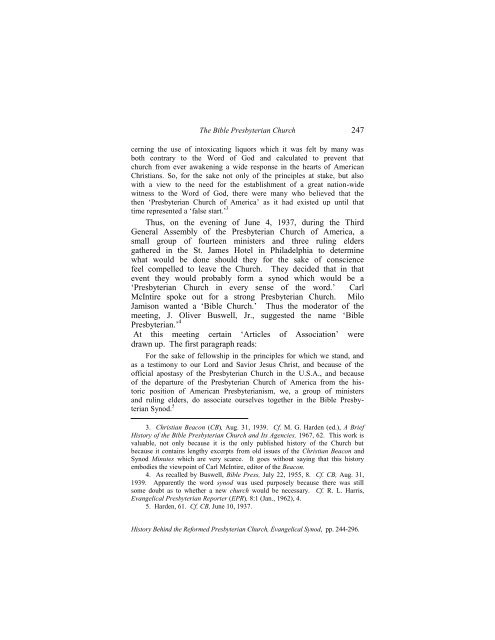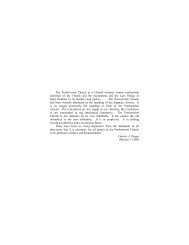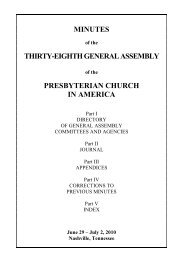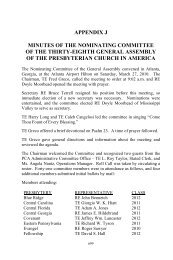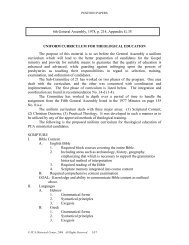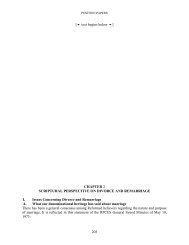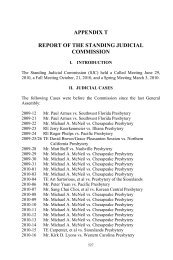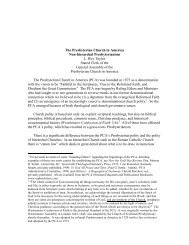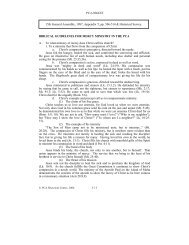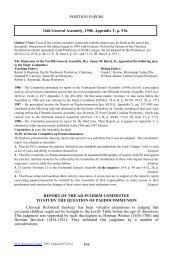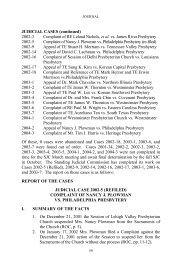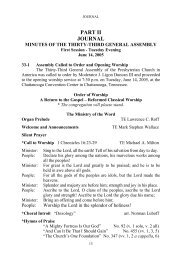Chapter 7: The Bible Presbyterian Church - PCA Historical Center
Chapter 7: The Bible Presbyterian Church - PCA Historical Center
Chapter 7: The Bible Presbyterian Church - PCA Historical Center
You also want an ePaper? Increase the reach of your titles
YUMPU automatically turns print PDFs into web optimized ePapers that Google loves.
<strong>The</strong> <strong>Bible</strong> <strong>Presbyterian</strong> <strong>Church</strong> 247cerning the use of intoxicating liquors which it was felt by many wasboth contrary to the Word of God and calculated to prevent thatchurch from ever awakening a wide response in the hearts of AmericanChristians. So, for the sake not only of the principles at stake, but alsowith a view to the need for the establishment of a great nation-widewitness to the Word of God, there were many who believed that thethen „<strong>Presbyterian</strong> <strong>Church</strong> of America‟ as it had existed up until thattime represented a „false start.‟ 3Thus, on the evening of June 4, 1937, during the ThirdGeneral Assembly of the <strong>Presbyterian</strong> <strong>Church</strong> of America, asmall group of fourteen ministers and three ruling eldersgathered in the St. James Hotel in Philadelphia to determinewhat would be done should they for the sake of consciencefeel compelled to leave the <strong>Church</strong>. <strong>The</strong>y decided that in thatevent they would probably form a synod which would be a„<strong>Presbyterian</strong> <strong>Church</strong> in every sense of the word.‟ CarlMcIntire spoke out for a strong <strong>Presbyterian</strong> <strong>Church</strong>. MiloJamison wanted a „<strong>Bible</strong> <strong>Church</strong>.‟ Thus the moderator of themeeting, J. Oliver Buswell, Jr., suggested the name „<strong>Bible</strong><strong>Presbyterian</strong>.‟ 4At this meeting certain „Articles of Association‟ weredrawn up. <strong>The</strong> first paragraph reads:For the sake of fellowship in the principles for which we stand, andas a testimony to our Lord and Savior Jesus Christ, and because of theofficial apostasy of the <strong>Presbyterian</strong> <strong>Church</strong> in the U.S.A., and becauseof the departure of the <strong>Presbyterian</strong> <strong>Church</strong> of America from the historicposition of American <strong>Presbyterian</strong>ism, we, a group of ministersand ruling elders, do associate ourselves together in the <strong>Bible</strong> <strong>Presbyterian</strong>Synod. 53. Christian Beacon (CB), Aug. 31, 1939. Cf. M. G. Harden (ed.), A BriefHistory of the <strong>Bible</strong> <strong>Presbyterian</strong> <strong>Church</strong> and Its Agencies, 1967, 62. This work isvaluable, not only because it is the only published history of the <strong>Church</strong> butbecause it contains lengthy excerpts from old issues of the Christian Beacon andSynod Minutes which are very scarce. It goes without saying that this historyembodies the viewpoint of Carl McIntire, editor of the Beacon.4. As recalled by Buswell, <strong>Bible</strong> Press, July 22, 1955, 8. Cf. CB, Aug. 31,1939. Apparently the word synod was used purposely because there was stillsome doubt as to whether a new church would be necessary. Cf. R. L. Harris,Evangelical <strong>Presbyterian</strong> Reporter (EPR), 8:1 (Jan., 1962), 4.5. Harden, 61. Cf. CB, June 10, 1937.History Behind the Reformed <strong>Presbyterian</strong> <strong>Church</strong>, Evangelical Synod, pp. 244-296.


